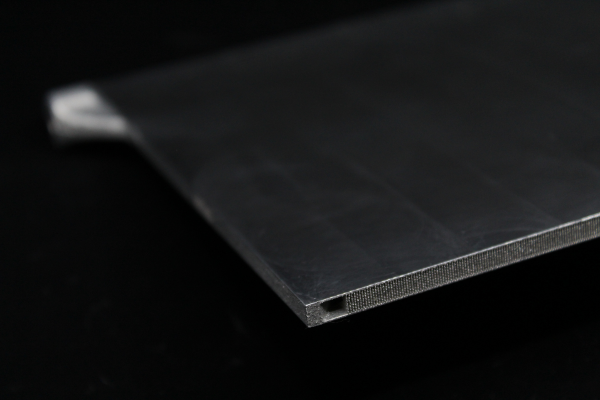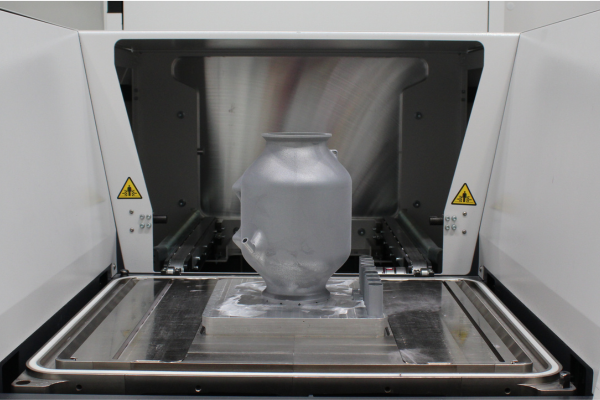The concept of Advanced Air Mobility (AAM) is a catch-all term for lightweight passenger and freight air transport, often in the urban environment. This emerging industry is growing rapidly, attracting $7 billion in new investment in 2021, with orders for approximately 6,850 aircraft worth over $26 billion [1].
At the heart of these electric Vertical Take Off and Landing (eVTOL) vehicles lies the electric powertrain. This consists of a lithium-ion battery along with high performance motors and inverters which generate the necessary lift and propulsion. There are a variety of different powertrain concepts currently being developed, however they all share the same thermal management challenges that come with high power and high voltage electronics.

The importance of thermal management in eVTOL aircraft
Managing the waste heat generated by electronic components in an aircraft propulsion system is crucial to performance, a characteristic shared with electric vehicle powertrains in the automotive world. Battery systems only work efficiently within a narrow window of operating temperatures and so require both pre-heating and cooling. Furthermore, the resistance and hysteresis losses within motors generate heat which can cause damage to the magnets and windings, while the silicon carbide in the inverters can also degrade if too hot.
For aircrafts, particularly small, lightweight eVTOLs, mass and propulsion system efficiency are essential to achieving a high range and payload capacity. Therefore, these electric powertrain components need to be effectively cooled with thermal management systems that are extremely lightweight and compact.
There are two approaches to cooling electronics; direct and indirect cooling. Direct cooling is where a fluid is in direct contact with the electrical components, which are submerged in a dielectric fluid. This allows heat to be extracted immediately from the source and there is no thermal resistance. However, flooding the electronics significantly increases weight, which is undesirable in an aircraft.
Indirect cooling on the other hand uses metallic heat sinks that contain channels of fluid and are attached to electronic components. This is typically how components within PCs and laptops are cooled using a fan to circulate air through a heat sink.

‘However, the amount of heat you can dissipate with air cooling is quite limited and requires a high mass flow rate,’ explains Dr. Jason Velardo, Thermal Engineer at Conflux Technology. ‘Whereas, liquid is denser than air which increases its cooling capacity.'
'The heat transfer performance of water in particular, along with its low viscosity makes it the best coolant for electronic devices. It has typically double the heat capacity of dielectric fluids which is why indirect cooling solutions such as cold plate liquid cooling with water are much more effective at dissipating heat, without adding too much mass.’
What is a cold plate heat exchanger?
Liquid cold plates are metallic heat sinks that consist of a closed-circuit liquid cooling system which pumps water through miniature channels within the cold plate and then on to a heat exchanger. They can be attached directly to the cells of a battery or stator of the motor and allow heat to be transferred from the component, through the metallic structure, to the coolant, which is often water or a water-glycol mixture.
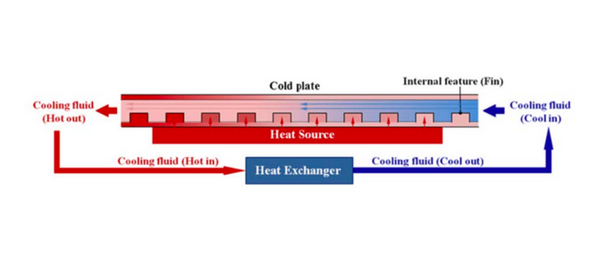
Cold plates are particularly suited to electronics because they allow the heat capacity benefits of water to be exploited whilst keeping the fluid in a sealed system, avoiding short circuits. The internal and external geometries can also be designed to minimise thermal resistance and reduce pressure drop in a compact package, something that additive manufacturing technologies are revolutionising.
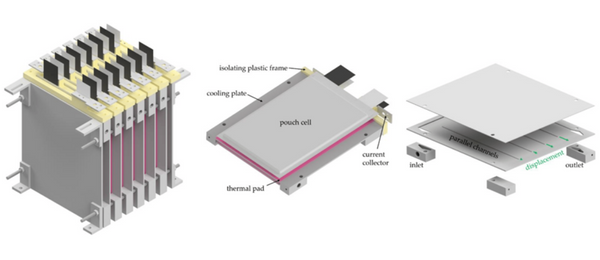
How are cold plates manufactured?
Traditionally, cold plates are manufactured from aluminium due to its low weight and good thermal properties. The cooling channels within the plates are generally formed by friction stir welding together two plates in which the required flow detail has been pressed or machined. However, these welded joints increase the risk of leakage and are also thermally inefficient as inhomogeneous joints can lead to air gaps which act as an insulator, rather than a conductor.
‘The welded structure is one of the challenges with traditional cold plates,’ explains Dan Woodford, Conflux Technology’s Chief Commercial Officer. ‘The risk of leakage is problematic and you are unable to create complicated internal structures. Whereas with additive manufacturing techniques, there is no welding or brazing and so you have one monolithic part with no joints and therefore no leaks.’
Conflux Technology use a Laser Powder Bed Fusion (LPBF) additive manufacturing process to create aluminium cold plates with complex geometries that are impossible to manufacture with traditional methods. The process uses a fibre laser to selectively melt a layer of fine metal powder. The build plate is then lowered and another layer of powder is applied. The laser melts the powder again and layer by layer, the part gradually builds up into a full 3D geometry.
Designing an effective cold plate
Achieving high heat transfer efficiency
Key to the performance of a cold plate design is thermal resistance. This determines how well heat is transferred across a system [2]. For a cold plate, the aim is to reduce the thermal resistance of the metallic structure so that the maximum amount of heat is transferred from the source to the coolant.
‘Theoretically, minimum thermal resistance requires zero thickness of your cold plate structure,’ says Velardo. ‘But in reality, the cold plate is providing structure as well as cooling, so you need as thin a wall as possible within the limits of strength, stiffness and manufacturability. One of the advantages of traditional manufacturing methods is that they can produce extremely thin walls via machining or skiving techniques but Conflux’s additive manufacturing technology is now getting very close to achieving the same wall thicknesses.’
Depending on the different materials used, such as aluminium in the diagram below, minimal wall and fin thinness can be achieved, creating an ultra-lightweight cold plate that delivers on performance.
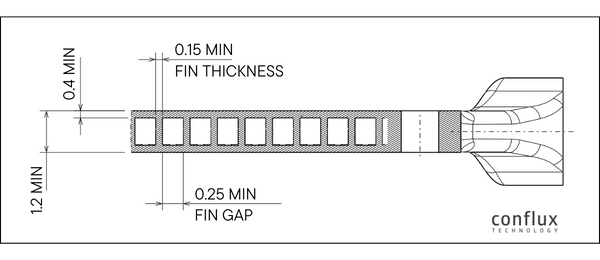
‘Additive manufacturing also has the benefit of creating novel shapes with complex internal geometries that are impossible to create any other way,’ continues Velardo. ‘This allows the internal structure of the cold plate to be designed to increase surface area.’
Fins, pins and gyroid structures [3] can all be incorporated within the cold plate design to not only increase the surface area, and therefore heat rejection, but also to optimise the behaviour of the flow. ‘
By directing the flow and using geometry to initiate turbulence, we can channel the coolant to hotter areas such as busbar junctions whilst also mixing the flow to dissipate heat more effectively,’ says Woodford.
Minimising pressure drop
The internal design of the cold plate has a direct effect on other elements of the cooling system. The pressure drop across the liquid coolant circuit defines the size and energy requirements of the pump. An efficient design means a smaller pump, lower mass and a lower energy drain on the battery system.
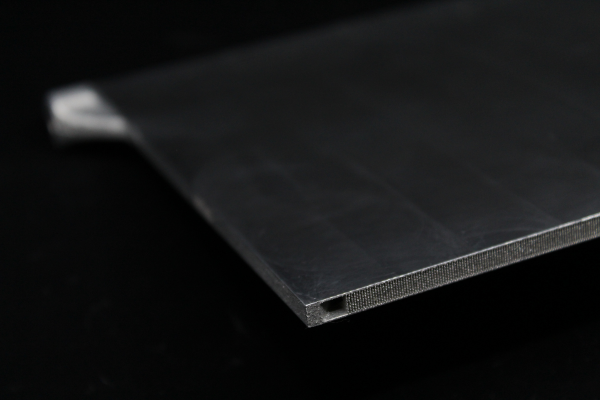
‘Conflux has the thermal design expertise and the simulation capability to create highly accurate CFD simulations of internal flow,’ explains Woodford. ‘These simulations, together with additive manufacturing means we can rapidly prototype and test new designs far more quickly than if we were using conventional press tools or machining.’
Compact packaging
Electronic components are often located in confined environments and therefore require compact and inventive thermal management solutions. This is particularly important in the restricted space of small eVTOL aircraft.
‘Additive manufacturing can create unique shapes that are very difficult to achieve with traditional methods,’ highlights Woodford. ‘For cooling high-power electronics we can design and manufacture bespoke cold plates that wrap around components such as inverters. We can also form ports and connections for the coolant circuit in any geometry or location to best package the whole assembly within the vehicle.’
‘Overall, the capabilities of additive manufacturing is moving cold plate cooling technology forwards to meet the new demands of the Advanced Air Mobility sector,’ concludes Woodford. ‘Our expertise in thermal management and additive manufacturing allows us to design, simulate, prototype and correlate bespoke cold plate designs much faster than has been possible before.’
References
[1] R.R., A.E., 2022. A milestone year for future air mobility [Online]. McKinsey and Company.
[2] The thermal resistance of microchannel cold plates [Online]. Advanced Thermal Solutions Inc.
[3] A.S., 1970. Infinite periodic minimal surfaces without self intersections [Online]. NASA.

